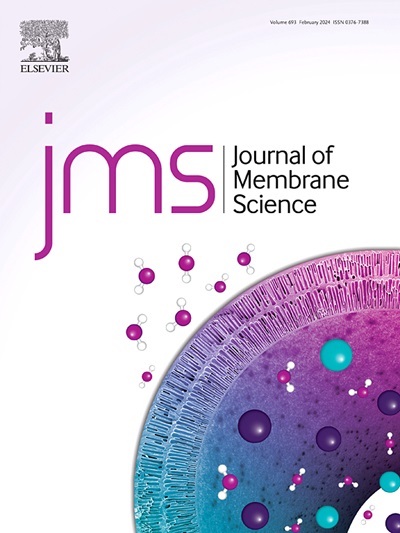Side-chain sterically induced directional units construct stable and continuous ion transport channels for anion exchange membranes
IF 8.4
1区 工程技术
Q1 ENGINEERING, CHEMICAL
引用次数: 0
Abstract
Improving the hydroxide conductivity and dimensional stability of anion exchange membranes (AEMs), while retaining their high alkaline stability, is essential for AEM water electrolysis (AEMWE). Herein, a novel design strategy is proposed for perfluorinated ionomer by introducing sterically induced directional units (SIDUs) at the termini of pendant side chains to achieve superior performance in both conductivity and stability. The design is centered on introducing an appropriate amount of rigid bulk benzyl groups based on fluorinated ionomer segments to driven the directional aggregation of cationic groups, thus enabling the construction of continuous and stable ion transport channels. The resulting Perfluorinated-tribenzyls AEM (PFTQ), by forming continuous and stable ionic channels that significantly enhance OH− and H2O mobility, exhibit an over 46 % and 65 % increase in self-diffusion coefficient compared to Perfluorinated-propyl AEM (PFPQ), achieving an exceptional conductivity of 167 mS cm−1 at 80 °C with a swelling ratio as low as 19 %. Moreover, the robust C–F bond backbone, coupled with the protective effects of SIDUs through electron-donating and steric hindrance on the cationic groups, allows the PFTQ with negligible degradation at 80 °C in 6 M KOH over 400 h. Based on this rational design, we achieved a high alkaline water electrolysis performance of 3.6 A cm−2 at 2.0 V and demonstrated durability of over 500 h at 1 A cm−2 at 80 °C. This study demonstrates that the AEM design strategy based on the introduction of SIDUs has significant potential in achieving excellent energy efficiency and extended stability for electrolyzers.

侧链立体诱导定向单元为阴离子交换膜构建了稳定、连续的离子传输通道
提高阴离子交换膜(AEMs)的氢氧化物导电性和尺寸稳定性,同时保持其高碱性稳定性,对AEM水电解(AEMWE)至关重要。本文提出了一种新的全氟离子单体设计策略,通过在垂侧链末端引入立体诱导定向单元(sidu)来获得优异的电导率和稳定性。设计的核心是在氟化离聚体段的基础上引入适量的刚性体苄基,驱动阳离子基的定向聚集,从而构建连续稳定的离子传输通道。由此产生的全氟化三苯AEM (PFTQ),通过形成连续和稳定的离子通道,显著提高OH -和H2O的迁移率,与全氟化丙基AEM (PFPQ)相比,其自扩散系数增加了46%和65%以上,在80°C下实现了167 mS cm - 1的优异电导率,膨胀率低至19%。此外,稳健的C - f键主链,加上sidu通过给电子和空间位阻对阳离子基团的保护作用,使得PFTQ在80°C、6 M KOH、400 h内的降解可以忽略。基于这种合理的设计,我们在2.0 V下实现了3.6 a cm−2的高碱性电解性能,并证明了在80°C下1 a cm−2的耐久性超过500 h。该研究表明,基于引入sidu的AEM设计策略在实现电解槽卓越的能源效率和扩展的稳定性方面具有巨大的潜力。
本文章由计算机程序翻译,如有差异,请以英文原文为准。
求助全文
约1分钟内获得全文
求助全文
来源期刊

Journal of Membrane Science
工程技术-高分子科学
CiteScore
17.10
自引率
17.90%
发文量
1031
审稿时长
2.5 months
期刊介绍:
The Journal of Membrane Science is a publication that focuses on membrane systems and is aimed at academic and industrial chemists, chemical engineers, materials scientists, and membranologists. It publishes original research and reviews on various aspects of membrane transport, membrane formation/structure, fouling, module/process design, and processes/applications. The journal primarily focuses on the structure, function, and performance of non-biological membranes but also includes papers that relate to biological membranes. The Journal of Membrane Science publishes Full Text Papers, State-of-the-Art Reviews, Letters to the Editor, and Perspectives.
 求助内容:
求助内容: 应助结果提醒方式:
应助结果提醒方式:


